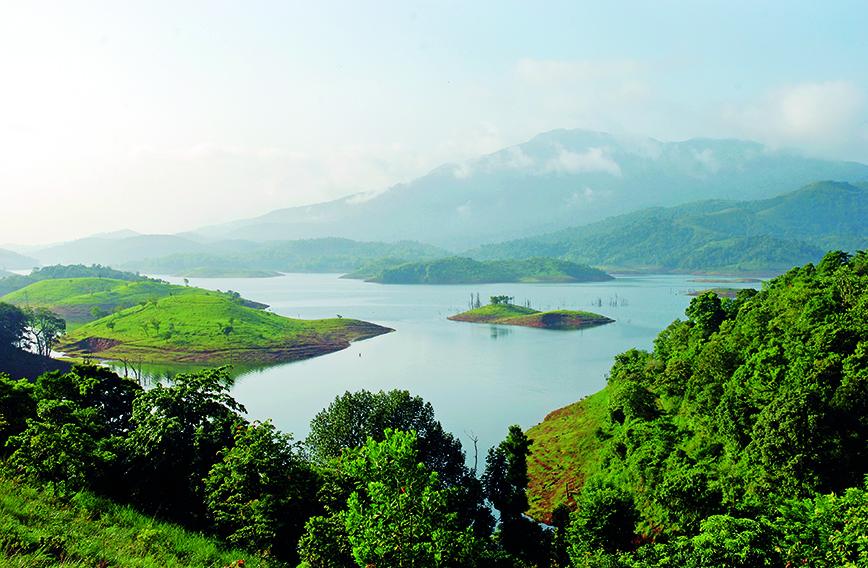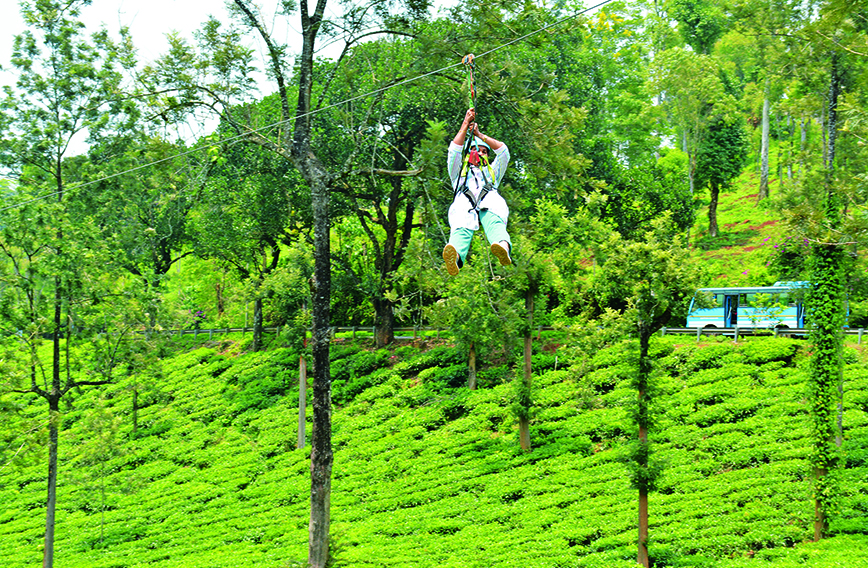
The backwaters of the Banasura Dam
In Wayanad for the rains and more
Susheela Nair
Reclining in the balcony of my glamp, a diaphanous igloo-like structure, in Mount Xanadu Resort, I watched a green expanse come into focus as the mist cleared to reveal hills, dales and lakes in the distance. There was nothing around to disturb the quietude in this paradise except the pitter-patter of rain and twittering birdcall.
Sipping steaming filter coffee over nibbles, I watched the rain interspersed with occasional thunder and lightning. The serenity was so soothing that I hardly felt like venturing out. But I had to — to attend Splash 2023, the biannual Monsoon Tourism Fest, touted as the second largest tourism event in what is truly God’s Own Country: Kerala.
“This mega event is special this year as it is happening after a three-year pandemic break,” said Vancheeswaran, president, Wayanad Tourism Organization (WTO), and event coordinator, Splash 2023.
Apart from rain lovers and hundreds of tourists, 700 stakeholders from the tourism fraternity descended on Wayanad to participate in the business-to-business (B2B) meet organized by the WTO in association with the Kerala Tourism and District Tourism Promotion Council.
When I first visited Wayanad in the late 1990s, it had only a handful of resorts and hotels. It has metamorphosed into an incredible destination with boutique resorts, homestays and hotels at every twist and turn.
“In 2019, when WTO introduced Wayanad Splash, the concept of rediscovering Kerala in the rains took root. This unique festival celebrates rain tourism, making the most dormant period of the year more marketable,” says Shylesh, secretary, WTO, and coordinator.
“Currently, through its aggressive marketing, the WTO, a consortium of hotels, homestays and hospitality partners, has elevated the region into one of India’s most preferred destinations. It all started with the biannual Splash festival during the monsoon when Wayanad beckoned tourists to explore the green vistas and experience the thrills of agrarian sports,” adds Shylesh.
When the monsoon breaks in Wayanad, it does so mightily and you might feel you are better-off in your hotel room. But the rains last from June to October, with the curtains of water thinning or thickening, and with mist-shrouded landscapes and teardrops of water on foliage up close to behold, Wayanad has an allure and charm of its own.
On days when the showers are light, one can take long, utterly invigorating walks across the coffee and spice plantations with an umbrella or drive to the sights or explore forested areas.
WTO arranges local experiences like farm-related activities with competitions in crab-catching, paddy transplantation, tree climbing and archery. Visitors can also experience the thrills and spills of mud football, off-roading over mountainous tracks, bamboo rafting, mountain biking, commando walking, tug-o’-war and monsoon trekking.
Visits can be arranged to stunning resorts in the lap of nature. Often, the drive to a mountain retreat is as incredible as the place itself. Local outdoor outfit Muddy Boots organizes kayaking, river crossing, hiking and cycling.
Wayanad leaves indelible images of verdant vistas in your mind: A century-old temple perched on a hillock, vast forest tracts, rushing rivulets and charming waterfalls like Soochipara and Meenmutty. Also unforgettable are the lush hillsides carpeted with tea, coffee, cardamom and pepper plantations and the wildlife sightings in the Muthanga and Tholpetty national parks.
 Ziplining through the tea plantations in Pozhuthana, Wayanad
Ziplining through the tea plantations in Pozhuthana, Wayanad
The verdant scenery, abundance of flora and fauna, and thick sprinkling of palms and areca groves make Wayanad a magical natural playground. For the adventurous, there are hills for trekking, for the religious there are sacred shrines. Those with an interest in history can explore the prehistoric Edakkal Caves, formed out of a strange disposition of three massive boulders on the crest of Ambukuthimala, a hill near Sultan Bathery.
This landlocked district is now a favoured destination for techies and tourists from Bengaluru because of its proximity to the city and strategic location at the trijunction of Kozhikode, Coorg and the Nilgiris.
Wayanad’s district headquarters is called Kalpetta. Unlike Kerala’s other district headquarters, it is not named after the district. In local parlance, Wayanad means paddy country, but there is hardly any trace of paddy here!
For the laidback, the ideal activity is a boat ride in the Pookote lake full of lotus blooms near Lakkidi or in the picturesque Banasura lake. For a whiff of raw adventure, try bamboo rafting or climb Chembra Peak, the tallest in this region with a heart-shaped lake. You will have, at 2,100m above sea level, a mesmerizing view of the landscape.
Tucked away in the woods, 900 Kandi (in local parlance it is known as Thollayirum Kandi) is named after the 900-acre sprawling estate that existed previously in this area. Off-road rides and treks, waterfall expeditions, campfires, hiking, birdwatching and biking are offered in this green wonderland. If you want to enjoy the thrill of walking on glass, head to the Glass Bridge to have a bird’s eye view of the luxuriant forest.
Sultan Bathery, the hilly eastern gateway to Wayanad, is an ideal base to visit the Edakkal Caves, Jain temple and Muthanga Wildlife Sanctuary. It was once known as Ganapathivattam, or the circle of Lord Ganapathi. The Sree Maha Ganapati temple is the only reminder of its past. Its name changed after Tipu Sultan marched in with his troops and used the 13th century Jain temple here as an ammunition dump. Over a period of time, Sultan Battery became Sultan Bathery. We had a peek at the Jain temple at Puthangadi, with its exquisite carvings.
The prehistoric Edakkal Caves, formed out of three massive boulders on the crest of Ambukuthimala, are about 10 km from Sultan Bathery. Edakkal means ‘the stone in between’ in Malayalam. You can spend endless hours trying to decipher the ancient carvings. Some of the pictorial wall inscriptions flaunt human figures with quaint headgear, images of a tribal king, a queen, an elephant, deer, swastika forms and symbols.
The Heritage Museum at Ambalavayil, showcasing artifacts of various tribes, has a collection of stone carvings, hunting traps, musical instruments, ornaments, terracotta figurines and pottery relating to the Megalithic Age. Some of the unique exhibits are engravings on stone slabs in the Vattezhuthus script and soft stone idols of tribal gods called Herostones.
For the spiritually inclined, there are hoary shrines like Thirunelly, Kottiyoor and Valiyoorkavu. From Kalpetta, one can explore the rest of the district’s highlights around Sultan Bathery, Mananthavady, Lakkidi and Vythiri. The sylvan environs of Kalpetta abound in sparkling waterfalls like Meenmutty, Kanthampara, and Soochipara which can be explored via jungle paths. A winding road past tea plantations followed by a trek through dense forest and rugged terrain took us to Soochipara Falls, also known as Sentinel Rock Falls or ‘needle rocks’ in Malayalam. The name is reflective of the sharp spikes of rock on which the water falls. It is exhilarating to watch it cascading down the hard granite rocks with a soaring spray engulfing you. Close by are the Kanthampara Falls and tucked in the dense forests are the ferocious Meenmutty Falls.
Equally enchanting are the Kuruva Dweep, a 950-acre maze of uninhabited islets and evergreen forests 16 km from Mananthavady, on the Kabini. Thickly-wooded, it is home to a variety of birds, butterflies, herbs and orchids, and is a bird sanctuary. Close to Mananthavady town is the tomb of Veera Pazhassi Raja, marking the place where he was cremated. Known as the Lion of Kerala, the raja fought a guerilla war against the British for nearly nine years by organizing the natives and the tribals.
Lakkidi, atop Thamrasseri Ghat at the district’s western border, acts like a gateway to Wayanad. Stop by the unusual Chain Tree to pay your respects to Karinthandan, a young tribal killed by a British engineer after the youth told him about a secret route across the once treacherous pass. When Karinthandan’s spirit started haunting travellers, his soul was pacified and chained to a large ficus that came to be known as Chain Tree.
_______________
FACT FILE
Getting there: The nearest airport and railhead are at Kozhikode. Take the Tamarassery Ghat Pass to Lakkidi, Vythiri and Kalpetta. There are private and government buses from Bengaluru to Kozhikode.
Stay: Xanadu Mount Resort, Taj Wayanad, Vythiri Resort. There is accomodation to suit every budget.
Comments
-

Sathyan Achath - Aug. 26, 2023, 5:09 a.m.
I enjoyed reading Ms. Suseela Nair’s article on Wayanad. It is very well written and has given an exhaustive picture on this beautiful place. I have never been to Wayanad but this article has motivated me to visit Wayanad in the near future.
-

Shiju Sugunan - Aug. 23, 2023, 11 a.m.
Your words painted a beautiful picture of Wayanad's misty allure and the soothing rain-soaked experience.




